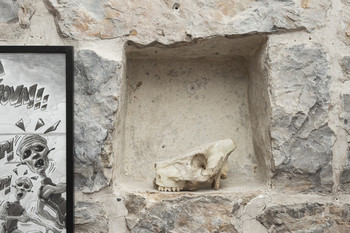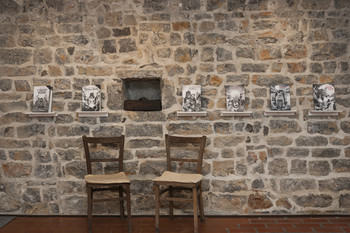Marko Kociper: The Badger and the Rest of the World
Ivan Grohar Gallery
18 September – 10 November 2024
Curator: Katerina Mirović
Coproduction: Stripburger/Forum Ljubljana
Marko Kociper is one of Slovenia’s most prolific comic artists. In his comics, he reveals people’s foibles and various social anomalies without mincing words and with lots of humour, and his distinctive drawing and narrative style is similarly blunt and forthright. Eroticism and satire are the main common threads of his work, and he often draws comics based on literary works, such as stories by Vinko Möderndorfer, Miha Mazzini, Andrej Blatnik or other authors. In recent years, he has also devoted himself to drawing stories about Fran Milčinski’s Butalci, i.e. unintelligent residents of a small village called Butale. A very important part of his oeuvre are the comic strips about a badger, who is certainly considered Kociper’s most famous (and most determined and fearless) comic strip character.
The Badger’s adventures, which so far have amounted to almost two trilogies, i.e. five comic albums, are a satire that can be classified as adventure comics. On the narrative level, the comics make for an exciting and dynamic comic story, which Kociper guides through many suspenseful moments with scriptwriting skill and plenty of wry humour. At the same time this fast-paced action, full of brutal plot twists and turns, as well as fierce erotic scenes that never fail to appear in Kociper’s comics, is reflected in the highly dynamic compositions and the rapid scene-to-scene transitions, much like in a film.
The exhibition on view at the Ivan Grohar Gallery features original pages from the Badger comics, drawn in black ink and enhanced with numerous crosshatches and greys created with acrylic paint. Brought to the fore are figures whose powerful and plastically modulated and often quite muscular bodies cover almost the entire panel space; they almost never stand still and move in such an intense way that they are constantly crossing the comic panel boundaries. All this is accompanied by a number of sounds, often so loud that they break free from the speech bubbles inside which they are usually written, passing into the drawing space together with the added emphasis on exclamation marks and question marks. The suspenseful comic reading is further enhanced by the extremely real life-like and juicy dialogues, which are not lacking in genuine colloquial language, slang expressions and witty ideas. The exhibition thus offers an excellent opportunity for the viewers to take a closer look at each of the exhibited comic pages as a stand-alone work of art and to look for details that are not as visible in book format, while at the same time getting to know the Badger and his world in a different dimension. In fact, the exhibition is designed as a spatial installation, and thus by entering the gallery, viewers become part of the Badger’s world.
In the first gallery room, we find ourselves in In Dark Waters, the latest episode of Badger’s adventures, whose release in the form of a stand-alone comic album is the exhibition’s primary focus. Alongside the drawings from the comic, the most striking part of the exhibition is a giant octopus painted on the wall, the most recent in the series of the Badger’s adversaries. Of course, there is also the very trunk that helped the Badger and his party escape the murky waters, as well as other objects that play an important role in the comic. Similarly, in addition to parts of the comics, drawings and illustrations, the second exhibition room also features numerous material specimens from the Badger’s life, created by the artist Andrej Štular and the sculptors Marko A. Kovačič and Rok Mohar, who have made the sculptures that give three-dimensional form to the characters from the Badger comics, thus making them part of our reality. Which, in fact, they have been all along.
From the very beginning, the Badger stories feature not only anthropomorphic animals, but also beings from other planets, i.e. aliens. These aliens add some science fiction elements, as well as our everyday social and political reality. In fact, they are the representatives of rich capitalists who want to take over the world and dominate it, without giving a toss what they shamelessly destroy, pollute or trample on the way to accomplishing their mission. The beings from other planets symbolise the external enemy, which the Badger – as someone who stands up for the rights of the weak – tirelessly confronts time and again. This is not only a thematisation of the eternal struggle of the common man against the rulers and the system, but even more so an allusion to the here and now, which is even more obviously concretised in Kociper’s The Holy Rage, a literary and visual critique of contemporary Slovenian society, power structures and greed, which is based on a text by Vinko Möderndorfer. Although The Holy Rage is not part of the Badger saga, the role of the preacher here is played by none other than the Badger, which is why the images from this work are also part of this exhibition. Here, the Badger appears in many other unusual roles, for example as a self-proclaimed singer, whose adventures were featured in the Polet magazine, or as a visitor to Cartoonia (Striponija) on a print titled Greetings from Poland.
The Badger’s many forms could not exist if Kociper had not invented him exactly the way he did. His character was inspired by the legends of the North American Indians, which feature a coyote in a central role. In his comics, Kociper has replaced the coyote with an animal that is quite widespread in Slovenian forests, but unlike bears, foxes, rabbits and other common animal characters, it rarely appears in literature, comics and art in general. And if it does, it does not have any typical pre-assigned characteristics defining its character. This allowed Kociper to shape the Badger in his own way: as an indigenous representative of the Slovenian soil, one that is not exactly virtuous and – although he appears in an animal form – is familiar with all things human. This makes him closer to us, mere mortals, than to some perfect comic book superheroes, who actually have little in common with the Badger, except that he too – although he is imperfect and far from exhibiting exemplary behaviour – is capable of solving just about every problem in one way or another. And above all, he is always ready to fearlessly tackle a new battle and embark on a new adventure. All he has to do first is have a coffee, smoke the obligatory cigarette, pull up his pants and he is once again ready for action.
Marko Kociper
Marko Kociper (1969) came onto the comic art scene in the mid-1990s, when, as a self-taught artist, he quickly attracted attention with his drawing bravura. He has published several comic book albums and his work has appeared in numerous publications (Stripburger, Apokalipsa, Mladina, Literatura, Dnevnik etc.); between 2005 and 2012, his comics were featured weekly in the Polet magazine. In recognition of his creative work, he won a working scholarship awarded by the Slovenian Association of Fine Arts Societies (ZDSLU). His works have been exhibited at numerous comic art festivals and other cultural venues.
Ana Bogataj
Accompanying programme
Wednesday, 30 October 2024, at 18:00: A guided tour of the exhibition with the artist and Jevgenij Skavčenko, PhD
























